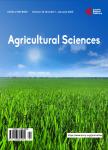Performance Assessment of Some Flax (<i>Linum usitatissimum</i>L.) Varieties Using Cluster Analysis under Sandy Soil Conditions
Performance Assessment of Some Flax (<i>Linum usitatissimum</i>L.) Varieties Using Cluster Analysis under Sandy Soil Conditions作者机构:Field Crops Research Department National Research Centre Dokki Egypt
出 版 物:《Agricultural Sciences》 (农业科学(英文))
年 卷 期:2014年第5卷第8期
页 面:677-686页
学科分类:1002[医学-临床医学] 100214[医学-肿瘤学] 10[医学]
主 题:Flax Linum usitatissimum Diversity Dissimilarity Agronomic Characters Cluster Analysis
摘 要:To assess the performance and the variability of 49 flax varieties based on agronomic parameters using cluster analysis, a field experiment was conducted in 2011/2012 and 2012/2013 winter seasons at the farm of the National Research Center at Nubria district, Albehira Governorate, Egypt. The results revealed high significant difference among all flax varieties in all the studied characters. Letwania-9 and Evelen cultivars surpassed all other varieties in seed and oil yields/fed. On the other hand, D variety gave the lowest value of seed yield/fed and F variety gave the lowest values of oil% and oil yield/fed. While, G Variety surpassed all other varieties in straw yield/fed. Blanka variety recorded the lowest values of straw yield/fed and biological yield/fed, while, Posna variety gave the lowest values of technical stem length (cm). In cluster analysis, all the studied characters were used to construct a distance matrix using the Euclidian coefficient, and generate dendrogram showing dissimilarity among all the varieties. Distance coefficient was ranged from 1.2 between Piltstar and Litwania-1 varieties and 10.8 between Posna and G varieties, which reveal the genetic diversity among varieties. The varieties can be divided into 4 groups based on cluster analysis.




